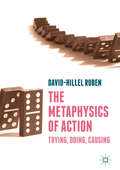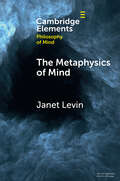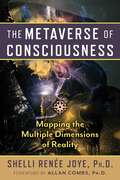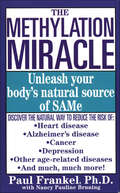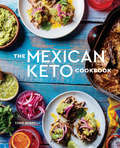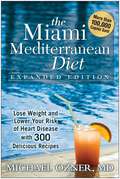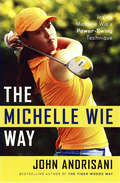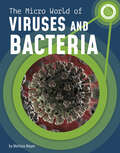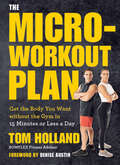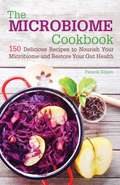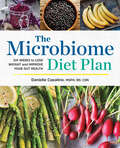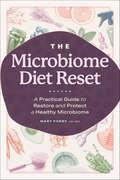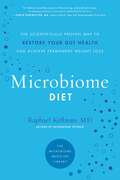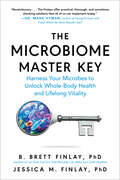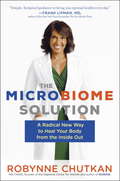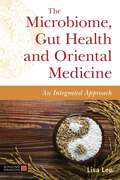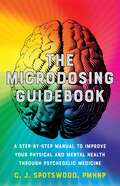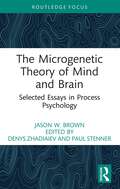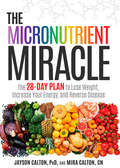- Table View
- List View
The Metaphysical World of Isaac Newton: Alchemy, Prophecy, and the Search for Lost Knowledge
by John ChambersNewton’s heretical yet equation-incisive writings on theology, spirituality, alchemy, and prophecy, written in secret alongside his Principia Mathematica • Shows how Newton’s brilliance extended far beyond math and science into alchemy, spirituality, prophecy, and the search for lost continents such as Atlantis • Explains how he was seeking to rediscover the one true religion that existed prior to the Flood of Noah, when science and spirituality were one • Examines Newton’s alternate timeline of prehistory and his study of prophecy through the Book of Revelations, including his prediction of Apocalypse in the year 2060 Isaac Newton (1643-1727) is still regarded by the world as the greatest scientist who ever lived. He invented calculus, discovered the binomial theorem, explained the rainbow, built the first reflecting telescope, and explained the force of gravity. In his famous masterpiece, Principia Mathematica, he described the mechanics of the physical universe with unimagined precision, proving the cosmos was put together according to laws. The perfection of these laws implied a perfect legislator. To Newton, they were proof that God existed. At the same time Newton was writing Principia Mathematica, he was writing a twin volume that he might have called, had it been completed, Principia Theologia--Principles of Theology. This other masterpiece of Newton, kept secret because of the heresies it contained, consists of thousands of essays providing equation-incisive answers to the spiritual questions that have plagued mankind through the ages. Examining Newton’s secret writings, John Chambers shows how his brilliance extended into alchemy, spirituality, the search for lost continents such as Atlantis, and a quest to uncover the “corrupted texts” that were rife in the Bibles of his time. Although he was a devout Christian, Newton’s work on the Bible was focused not on restoring the original Jewish and Christian texts but on rediscovering the one true religion that existed prior to the Flood of Noah, when science and spirituality were one. The author shows that a single thread runs through Newton’s metaphysical explorations: He is attempting to chart the descent of man’s soul from perfection to the present day. The author also examines Newton’s alternate timeline of ancient history and his study of prophecy through the Book of Revelations, including his prediction of an Apocalypse in the year 2060 followed by a radically transformed world. He shows that Newton’s great hope was that these writings would provide a moral compass for humanity as it embarked upon the great enterprise that became our technological world.
The Metaphysics of Action: Trying, Doing, Causing
by David-Hillel RubenIn this book, the author provides an account of three central ideas in the philosophy of action: trying to act, acting or doing, and one’s action causing further consequences. In all three cases, novel theories of these phenomena are offered: trying to act is not a particular mental or physical act but can be explained using conditionals; that action is not the same as causing something to happen; and in the case of a special but important subset of actions, for example the opening of a window, the action is identical to the event of the window’s opening. A result of this last account is that it places actions out in the world, sometimes far removed in time and space from the actor’s body. The world is full of action; actions do not just exist in the many little islands of space and time that all of our bodies inhabit. In the final chapter, Ruben describes and discusses a skeptical challenge to the idea that we can ever know whether or not someone else has acted, rather than just passive events having happened to that person.
The Metaphysics of Mind (Elements in Philosophy of Mind)
by Janet LevinThe Metaphysics of Mind presents and discusses the major contemporary theories of the nature of mind, including Dualism, Physicalism, Role-Functionalism, Russellian Monism, Panpsychism, and Eliminativism. Its primary goal is to examine the strengths and weaknesses of the theories in question, including their prospects for explaining the special qualitative character of sensations and perceptual experiences, the special outer-directedness of beliefs, desires, and other intentional states, and—more generally—the place of mind in the world of nature, and the relation between mental states and the behaviors that they (seem to) cause. It also discusses, briefly, some further questions about the metaphysics of mind, namely, whether groups of individuals, or entire communities, can possess mental states that cannot be reduced to the mental states of the individuals in those communities, and whether the boundaries between mind and world are as sharp as they may seem.
The Metaverse of Consciousness: Mapping the Multiple Dimensions of Reality
by Shelli Renée Joye• Develops the concept of the metaverse, the &“transcendental universe,&” composed of additional hidden dimensions operating in parallel with space and time• Integrates and maps the theories of consciousness developed by Carl Jung, David Bohm, Pierre Teilhard de Chardin, and other scientists• Offers the reader a path into the hidden dimensions through detailed maps of psyche, mind, and cosmosThe "metaverse"—as this wider universe is now coming to be known—is rooted in one interconnected consciousness that encompasses space and time as well as previously unknown dimensions only recently detected. In this book, Shelli Renée Joye, Ph.D., offers ways in which to visualize, enter, and explore a multitude of these transcendent, nonspatial, and nontemporal states and stages of consciousness as she reveals vast webs of interlinked consciousness forming a single universal psyche.Joye integrates the ideas of modern scientist-philosophers who view reality as a projection of a single multidimensional consciousness: Carl Jung and his concept of the psychoids, Pierre Teilhard de Chardin and his vision of an integrated noosphere of consciousness, and the quantum maps of consciousness developed by Karl Pribram and David Bohm. The book culminates with a call to explore transcendental consciousness by developing and following our own uniquely personal paths with which we too can enter the wider dimensions of awareness in the metaverse.
The Methylation Miracle: Unleash Your Body's Natural Source of SAMe
by Nancy Pauline Bruning Paul FrankelJump-start your body’s SAMe production and reduce the risk of heart disease, Alzheimer’s disease, cancer, depression, and other age-related diseases.Suddenly everyone is buzzing about SAMe, an extraordinary natural chemical we all manufacture. When SAMe levels are increased, some amazing things start happening—many people have found relief from such debilitating illnesses as depression and liver disease.Now, based on his own revolutionary findings, Dr. Paul Frankel explains a safe, natural, groundbreaking program of supplements, diet changes, and lifestyle modification that will enhance your body’s natural methylation process—the one that creates SAMe. This biochemical reaction also reduces the risk of cancer, premature aging, and heart disease as well as protecting our bodies from harmful toxins, promoting optimum health and well-being.Discover The Methylation Miracle today and find out how this extraordinary program can dramatically improve your health, and enhance the quality and duration of your life!
The Mexican Keto Cookbook: Authentic, Big-Flavor Recipes for Health and Longevity
by Torie BorrelliContaining more than 100 low-carb, high-fat, anti-inflammatory recipes, The Mexican Keto Cookbook provides insight into the history of Mexican cuisine while also adding a flavorful, international flair to the popular keto diet.In contrast to the typical Mexican American diet--the result of busy schedules, tight budgets, and high-sugar, white flour foods of convenience-- The Mexican Keto Cookbook is packed with authentic, full-flavored, health-conscious recipes designed to burn body fat. It includes the science behind keto, guides you on how to execute the diet effectively, and provides more than 100 amazing recipes. Integrative holistic nutritionist Torie Borrelli tapped into her Mexican heritage to create keto-friendly staples of Mexican cuisine such as Salsa Bandera, Nopales Salad, and Sopa de Albondigas; quick and easy weeknight dinners such as Chicken Tortilla Soup, Goat Cheese Enchiladas, and Spicy Cilantro Chicken Wings; and hearty crowd-pleasers such as Fish Tacos and Turmeric Caper Cauliflower. With this very first low-carb, anti-inflammatory, high-fat Mexican ketogenic cookbook on hand, you can enjoy all the fun and flavor of your favorite Mexican foods while reaping the many health, weight loss, and other benefits keto has to offer.
The Mexican Witch Lifestyle: Brujeria Spells, Tarot, and Crystal Magic
by Valeria RuelasDiscover the vibrant culture of brujeria and embrace your own inner witch with this essential guide to spellcasting, spirit worship, tarot, crystals, and all the other elements of this increasingly popular lifestyle.A modern Mexican bruja is a powerful person, one who reads the tarot and performs spellwork and rituals of devotion to their spirit guides and deities. Brujeria, which translates as witchcraft in Spanish, is a unique form of spirituality that blends core elements of Afro-Indigenous beliefs. Having originated in Mexico, brujeria is now practiced in Latinx communities across the world. Valeria Ruelas was raised living every aspect of the brujeria lifestyle. From shopping at botanicas and yerberias, to casting spells, to interpreting tarot readings, Valeria has today become one of the foremost practitioners of brujeria in the US. And as part of her daily practice, she seeks to bring the intense wisdom, harmony, and spirituality that comes with living this bruja lifestyle to her followers and returning power and ancestral magic to those whose agency has been lost. Within these pages, Valeria provides you with an expert&’s introductory handbook for all the aspects of brujeria, including, -Respectfully shopping at a yerberia or botanica -A complete guide to common crystals -Essentials for your altar -A introduction to tarot -Spells to bring luck, love, and good fortune -The secrets of Santa Muerte Comprehensive and inspiring, The Mexican Witch Lifestyle is the perfect guide for anyone curious to learn more about this vibrant culture of witchcraft.
The Miami Mediterranean Diet: Lose Weight and Lower Your Risk of Heart Disease
by Michael OznerObesity, diabetes, heart disease and cancer—all diseases that have been scientifically linked to diet—are at an all-time high, and the recent popularity of low-carb, high-fat diets has only made things worse. But there's a way that's been successful for millions of people for thousands of years: the Mediterranean diet. In The Miami Mediterranean Diet, noted Miami cardiologist Michael Ozner updates the traditional Mediterranean diet—clinically proven to reduce your risk of heart disease, cancer and numerous other diseases—with the latest scientific findings in health and nutrition to create a diet that's easy to follow. With more than 300 delicious recipes, from soups to omelets, from salads to desserts, as well as an abundance of evidence supporting the Mediterranean diet's incredible health benefits, The Miami Mediterranean Diet shows you how and why to change your life for a longer, healthier, happier life.
The Michelle Wie Way: Inside Michelle Wie's Power-Swing Technique
by John AndrisaniGolfer Michelle Wie has been called everything from a child prodigy to golf phenomenon to golfing genius, as if she were born with the talent to hit superlong drives and a wide variety of other creative, on-target power-shots. In fact, Wie has worked darn hard to evolve into the most exciting player to hit the links since Tiger Woods. Average players who struggle every day to improve at golf are awestruck by Michelle Wie. Naturally, since the majority of golfers are obsessed with distance, they come to observe Wie drive the ball in the hope that they will discover a single technical key to picking up extra yards off the tee. The main focal point of this book is natural power: secrets to hitting long drives by swinging the club with superefficiency and picking up extra carry and roll by hitting a high power-draw drive-the Michelle Wie Way. Book jacket.
The Micro World of Dust Mites and Other Microscopic Creatures (Micro Science)
by Melissa MayerDid you know that there are animals all around you that you can’t see without a microscope? Sometimes it’s good you can’t see them. As you shed dead skin cells, thousands of dust mites gobble them up. Gross! Tiny water bears are super tough. They can survive in Earth’s coldest and hottest places and even in space! Young readers will learn amazing, weird, and sometimes gross facts about a variety of microscopic creatures.
The Micro World of Viruses and Bacteria (Micro Science)
by Melissa MayerThe world is full of tiny viruses and bacteria that can be seen only through a microscope. Some bacteria can be helpful, but others cause diseases such as typhoid fever. Viruses can cause deadly diseases such as COVID-19. Young readers will get all the facts about bacteria and viruses, including their similarities and differences, how they cause infections, and how people can keep dangerous germs from spreading.
The Micro-Workout Plan: Get the Body You Want without the Gym in 15 Minutes or Less a Day
by Tom HollandDitch the gym! It&’s not about how long you exercise—or where—but about the type of moves you do. Bowflex Fitness Advisor Tom Holland introduces micro-workouts for optimal health that will help you achieve the body you want. Does the prospect of spending long hours at the gym deter you from exercising? Tom Holland has a much better approach: &“excessive moderation&” utilizing manageable micro-workouts that provide maximum, long-term results by engaging your full body, elevating your heart rate, accelerating physical conditioning, and increasing circulation and energy. They&’re perfect for the busy people who don&’t have time for the gym and want to exercise when, where, and for however long they want. In The Micro-Workout Plan, Tom shares the knowledge he&’s gained from 30 years in the fitness industry, debunks myths, explains why micro-workouts succeed, and offers a motivating, manageable method for fitness well-being. He provides actionable steps with 30 5-minute mix-and-match micro-workout routines: just two to four 5-minute micro-workouts a day done whenever and wherever you want will target your whole body and help you achieve the daily activity required for optimal health. Plus, there&’s a step-by-step photographic section of 80 exercises teaching proper form. With this book in hand, you can ditch the gym and get the same experience at home.
The Microbial Challenge: A Public Health Perspective
by Robert I. Krasner Teri ShorsMicrobes play a highly significant role in our daily lives as agents of infectious disease and are a major public health concern. The third edition of The Microbial Challenge: A Public Health Perspective addresses this topic and has been extensively revised and updated with the latest data in a fast-paced field. It focuses on human-microbe interactions and considers bacterial, viral, prion, protozoan, fungal and helminthic (worm) diseases. A chapter on beneficial aspects of microbes makes it clear that not all microbes are disease producers and that microbes are necessary for the sustenance of life on Earth. The response of the immune system, concepts of epidemiology, and measures of control from the individual to the international level to thwart potentially life-threatening epidemics are described. Sections on fungi and fungal diseases are new. The third edition includes new and contemporary information on vaccinations, antibiotic resistant microbes, practical disinfection information, virotherapy and emerging diseases. New boxes throughout the text feature items of human interest such as big and bizarre viruses, probiotics, rats, and synthetic biology.
The Microbiology Laboratory: An Introduction to Clinical Microbiology Concepts AND Techniques
by Margaret WareThe goal of this text is to instill a basic curiosity about and respect for microorganisms as students prepare for their future health care professions. The Microbiology Laboratory: An Introduction to Clinical Microbiology Concepts and Techniques promotes the understanding of how microorganisms live and spread, as well as how to deter their presence when needed. This text stresses the importance of constant vigilance in both quality control and infection control practices. Using simulated patient cases, the text introduces identification techniques as well as the importance of effective communication in quality patient care. Experiments utilize demonstration, critical thinking, and discovery to clarify and solidify important concepts regarding microbial life while remaining directly applicable to challenges encountered daily. In addition to the more traditional activities, several exercises draw directly from student discussion of current events to utilize hands on exploration of relevant questions. The introduction to each lab exercise provides background information to help solidify the “why” behind the many details found in best practices required of health care professionals. The knowledge and experiences gained through these lab activities contribute to an early development of vigilant microbial control practices as a lifelong habit. This text requires little previous science background and assumes only basic math skills. Exercises do not require a large investment in equipment, utilizing hands-on experiences over automated alternatives, making it suitable for a wide variety of instructional situations.
The Microbiome Cookbook: 150 Delicious Recipes to Nourish your Microbiome and Restore your Gut Health
by Pamela EllgenDiscover the power of fixing your microbiome and gut health with this cookbook from a bestselling health and diet author.The gastrointestinal microbiota comprises hundreds of trillions of bacteria, viruses and fungal organisms that inhabit your intestines and live symbiotically with you. When the microbiome is disrupted, a cascade of complications can ensue, including allergies and food sensitivities, mental health problems, weight gain, irritable bowel syndrome and autoimmune diseases.The Microbiome Cookbook provides you with the information and recipes to support a flourishing gut population. Follow the program in this book and you will gain the many benefits of having a healthy microbiome to naturally:• Improve digestion• Neutralize toxins• Quell inflammation• Support immunity• Boost metabolism
The Microbiome Diet Plan: Six Weeks to Lose Weight and Improve Your Gut Health
by Danielle Capalino MSPH, RD, CDNFeed your inner self to lose weight and feel great.Have you fed your microbiome today? The ecosystem of microbes in your gut affects your digestion, weight, energy level, and more. The Microbiome Diet Plan will help you nurture a healthy microbiome for a healthy life.You'll start by restoring your microbes to their happy place. Then, learn to sustain those positive changes for improved digestion, increased energy, and better sleep. This microbiome diet plan includes practical info like food charts, shopping lists, and lifestyle tips. Many of the recipes are grain-free, dairy-free, nut-free, or vegan.The Microbiome Diet Plan includes:Two-phase meal plan—Restore and sustain your gut health with a full 6-week microbiome diet meal plan.More than 125 recipes—Enjoy Sweet and Savory Orange Walnut Salad, Korean Beef Tacos with Red Slaw, Cinnamon Rice Pudding, and other tasty dishes.DIY fermentation—Make good-for-your-gut fermented creations like sauerkraut and kimchi, or even Fermented Salsa or Fermented Cranberry Sauce!Lose weight and find peace from the inside out with The Microbiome Diet Plan—your digestive system will thank you!
The Microbiome Diet Reset: A Practical Guide to Restore and Protect a Healthy Microbiome
by Mary PurdyA healthier microbiome begins by changing your diet and your lifestyleCultivating a healthy gut is the key to better overall health and well-being. The Microbiome Diet Reset will get you on the right path with easy, affordable recipes you can make in minutes as well as practical recommendations to rehabilitate and maintain a well-balanced microbiome.From sour 'n' spicy Kimchi to hearty Four Bean Chili, this combined cookbook and meal plan delivers everything you need to kick-start a bacteria-friendly microbiome diet. You'll boost your metabolism and your immune system while enjoying more fresh vegetables, fermented foods, beans, and whole grains. Reset with this microbiome diet—your gut will love you for it!The Microbiome Diet Reset features:Restorative recipes—Discover dozens of delicious prebiotic-packed and probiotic-friendly microbiome diet options.Meal planning—Explore two weekly menus, including one for regular eaters and one that's FODMAP-friendly for those with sensitive stomachs.Essential extras—Get a brief overview of your microbiome, time-saving tips and tricks, sample shopping lists, and more.Boost immunity and improve digestion with The Microbiome Diet Reset.
The Microbiome Diet: The Scientifically Proven Way to Restore Your Gut Health and Achieve Permanent Weight Loss (Microbiome Medicine Library)
by Raphael KellmanCutting-edge science has shown that the microbiome is the secret to healthy weight loss and to feeling healthy, energized, optimistic, and at the top of your game. The microbiome is a whole inner world that lives within your intestines--trillions of tiny microbes that help you extract the nutrients from your food, balance your mood, and sharpen your clarity and focus. These beneficial bacteria make up a separate ecology within the body and have an enormous influence on your metabolism, your hormones, your cravings--even your genes. The microbiome's health is intimately involved with yours: when it flourishes, you flourish. When it craves sugar, so do you. When it operates at peak efficiency, so does your metabolism. And when your microbiome is out of balance, you might find yourself gaining weight or unable to lose weight, no matter how much you exercise or how carefully you eat. To achieve your ideal weight, you need the help of your microbiome. Now, drawing from nearly two decades of experience as a specialist in functional medicine and intestinal health, Raphael Kellman, MD, has developed the first diet based upon on these scientific breakthroughs. The Microbiome Diet offers an effective three-phase plan to heal your gut, reset your metabolism, and achieve dramatic, sustainable weight loss. The Microbiome Diet will help you. . . Reset your metabolism Free yourself from food cravings and uncontrollable appetite Incorporate prebiotics, probiotics, and healing foods into every meal Lose weight--and keep it off--with a nonrestrictive life plan With delicious recipes, convenient meal plans, and helpful information on Microbiome Superfoods and Supersupplements--including prebiotics and probiotics--The Microbiome Diet gives you the tools to achieve your healthy weight, boost your mood, regain your mental focus, and be in your best shape for life.
The Microbiome Master Key: Harness Your Microbes to Unlock Whole-Body Health and Lifelong Vitality
by B. Brett Finlay Jessica M. FinlayLearn the secret to whole-body, lifelong health: the teeming world of microbes inside and all around you. Hand sanitizer. Social distancing. Antibiotics. Fending off germs has long been considered one of the cornerstones of good health. But what if better health and more graceful aging actually went hand-in-hand with embracing microbes? Your body is teeming with microbes—not just in the gut, but also on your skin, in your lungs, and beyond. And they impact everything from your sleep, cognition, mood, heart health, and energy to your likelihood of developing many diseases. As groundbreaking new studies are showing, taking care of your microbiome—inside and out—can help you improve your day-to-day health and even help prevent or reverse some of the most common age-related diseases. This eye-opening book breaks down what the latest research says about how the microbiome affects all aspects of physical and mental health—and what you can do about it. • Potentially change the trajectory of 9 out of 10 leading causes of death, including heart disease, cancer, lung disease, stroke, Alzheimer’s disease, and diabetes • Increase your resistance to pathogens like the flu and COVID-19 • Keep your skin soft, healthy, supple, and less wrinkled • Stabilize your weight and control blood sugar • Improve your physical fitness and strength • Fight "inflammaging"—low-grade inflammation that hastens the aging process • Get a more restful and rejuvenating night’s sleep • Reduce stress and improve mental health—and your long-term quality of life The Microbiome Master Key is an updated and expanded new edition of The Whole-Body Microbiome.
The Microbiome Solution
by Robynne ChutkanThe author of Gutbliss and one of today's preeminent gastroenterologists distills the latest research on the microbiome into a practical program for boosting overall health. Michael Pollan's widely discussed New York Times article, "Some of My Best Friends Are Germs," was just the tip of the iceberg. The microbiome--the collective name for the trillions of bacteria that live in our gut--is today's hottest medical news topic. Synthesizing the latest findings, Dr. Robynne Chutkan explains how the standard Western diet and lifestyle are starving our microbiome, depleting the "good bugs" that keep us healthy and encouraging overgrowth of exactly the wrong type of bacteria. The resulting imbalance makes us more prone to disease and obesity and negatively affects our metabolism, our hormones, our cravings, our immunity, and even our genes. But beyond the science, what sets this book apart is Dr. Chutkan's powerful three-level program for optimizing your gut bacteria for good health.Dr. Chutkan shares:Why hand-sanitizing gels and antibiotics are stripping our bodies of their natural protective systemsEssential prebiotics and probioticsRecipes with ingredients that replenish the microbiome for each rehab levelCutting-edge research on the connection between the microbiome and the brainAn intro to the stool transplant, the superfix for a severely troubled microbiome Dr. Chutkan is one of the most recognizable gastroenterologists working in America today, and this is the first book to distill the research into a practical, effective plan for replenishing our microbiomes. The Microbiome Solution will bring welcome relief to the millions who want to grow a good "gut garden"--and enjoy healthier, happier lives.
The Microbiome, Gut Health and Oriental Medicine: An Integrated Approach
by Lisa LeeThe human microbiome and its resident micro-organisms have in recent years come to represent a new frontier in health research and science. Yet this body of knowledge has hitherto been little addressed within Oriental Medicine theory and has consequently been underutilised in practice. The book proposes a novel and ground-breaking approach to understanding and influencing gut health and the microbiome by integrating the latest evidence from Western medical research and the long-established theory and practice of Oriental medicine. Building on an understanding of the body as a complete ecosystem where symbiotic relationships maintain balance in both mind and body, this integrative model sheds new light on an area that has seen rapidly growing interest both in and out of scientific communities, providing a more holistic and comprehensive perspective that both unites and broadens the potential applications of microbiome knowledge across medical and therapeutic traditions.The book's focus on the microbiome of the gastro-intestinal tract allows to explore the far-reaching and wide-ranging effects of the gut's micro-organisms on other body systems, on their ability to maintain good physical and mental health, and to fight disease and illness. This emphasis further provides readers with a practical guide to understanding and supporting a well-functioning gut and microbiome, through lifestyle choices and practices that focus on eating well, sleep hygiene, and mindful living.The booming interest in the area of gut health makes this compelling, accessible and informative hands-on book, an important tool for patients and practitioners of Oriental medicine and other relevant disciplines, offering readers a unique opportunity to add a new dimension to their knowledge of gut health. It will allow practitioners to deepen their professional development and enhance the quality of the care they provide by honing therapeutic skills and creating hybrid treatment plans that combine the latest findings from the gut-health literature and Oriental medicine.
The Microdosing Guidebook: A Step-by-Step Manual to Improve Your Physical and Mental Health through Psychedelic Medicine
by C.J. SpotswoodLearn about the history, research, and helpful effects of microdosing psychedelic medicines like psilocybin, LSD, ecstasy, and more with this combination manual and workbook.Microdosing, or taking between 1/10th and 1/20th of the normal dose of a psychedelic drug is the latest way to improve performance, stave off chronic pain, and alleviate a variety of other ailments like anxiety and depression. Unlike a psychedelic trip, microdosing does not alter your mental status or interfere with day-to-day life. Part handbook and part workbook, The Microdosing Guidebook is your ultimate reference for safely using psychedelic medicine. Inside you&’ll find: The most up-to-date research on psychedelics A complete history of psychedelics and their medicinal uses How to find the correct dose for your unique body and situation A place to track your experiences and improvements And much more! Whether you have experience with psychedelics or are simply curious to learn more, The Microdosing Guidebook has everything you need to get started on your healing journey.
The Microgenetic Theory of Mind and Brain: Selected Essays in Process Psychology
by Jason W. BrownThis book asks where ideas, objects and feelings come from and how they arise via an exploration of the nature of subjective experience and its relation to the world. Seeking an explanation for the experience of subjective duration and the present and in contrast to the conception of mental events as non-temporal logical solids, it explores a diachronic processual theory founded on psychological data and clinical observation that provides an explanatory “system” of thought adequate to the phenomena it is called on to explain. The author focuses on the intra-psychic sources and nature of subjective experience, with the intent of examining a variety of phenomena from the standpoint of microgenetic theory. The chapters deal with the origins of human subjectivity and the epochal nature of time and duration, change and the relevance of a theory of the mental state to dream and the waking present. Based on speculative psychology that flows from case studies in neuropsychology and concepts in process philosophy, it advances a theory of mind and brain that brings together previous, fragmentary research studies on this topic.
The Micronutrient Miracle: The 28-Day Plan to Lose Weight, Increase Your Energy, and Reverse Disease
by Jayson Calton Mira CaltonOur poor health and growing waistlines can be traced back to the hidden crisis of a micronutrient deficiency. More than 90 percent of all Americans are deficient in at least one of these health-promoting vitamins and minerals and don't even know it. According to nutritionists Jayson and Mira Calton, micronutrients--vitamins and minerals essential for optimum health--are being stripped from our diet and depleted by our lifestyle habits. And these deficiencies cause today's most common illnesses. Mira herself developed advanced osteoporosis at the age of 30. But with Jayson's help, she reversed her disease through micronutrient therapy. The Caltons created The Mircronutrient Miracle, an incredible cure-all program, to help you lose weight and prevent and reverse common disorders, including obesity, heart disease, and diabetes. The Micronutrient Miracle explains the truth about what you're really eating and how your habits may be depleting essential micronutrients. It also provides an easy-to-follow 28-day plan to reverse these effects by restoring your depleted micronutrients. And the best part? This book is tailor-made to work with your lifestyle, including gluten-free, low-carb, low-fat, vegan, and Paleo recipes!
The Middle Place
by Kelly CorriganThe Middle Place is memoir at its highest form. For Kelly Corrigan, family is everything. At thirty-six, she had a marriage that worked, two funny, active kids, and a weekly newspaper column. Then she went to the doctor...

